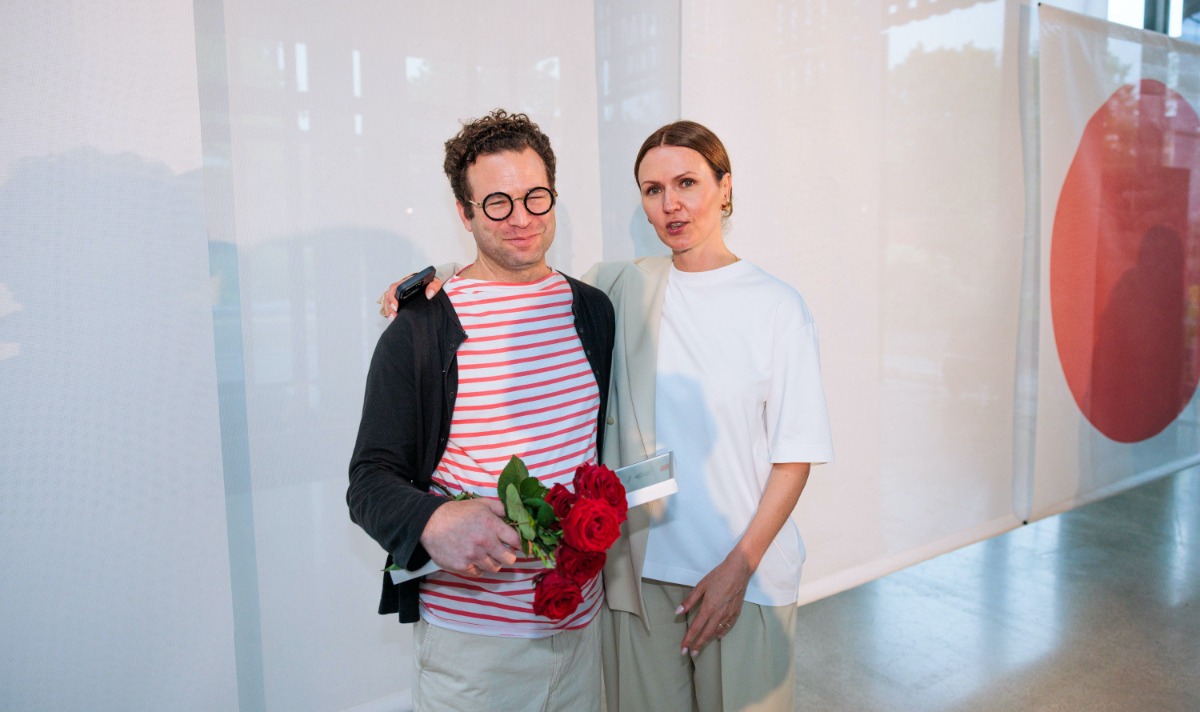
Things we can do together
A conversation with Jeffrey Rosen, a Tokyo-based gallerist, just before the opening of Riga Contemporary – the new art fair he helped organise
When we spoke with Jeffrey Rosen, sitting on the steps at the entrance to Hanzas Perons, the space around us was still rather empty – at least compared to what would unfold there just a day later. The opening of the Riga Contemporary art fair on the evening of August 10th seemed to gather everyone, or almost everyone, connected to contemporary art or simply interested in it. And the main impression is this: despite the fact that galleries from all over the world – from the Baltics to the USA and Japan – are represented here, they all speak the same visual language.
Forty-three galleries from sixteen countries are showing works by eighty-five artists. And it’s a vibrant, striking language – one that broadens our perception and way of thinking. A language that always slightly slips away, remains ambiguous, and doesn’t demand an immediate or loud reaction. The first edition of the fair seems clearly a success, and on the opening night, many conversations revolve around the hope that this event will continue. Because Riga has long deserved something like this – bright, intellectual, and truly contemporary.
At the opening of Riga Contemporary at Hanzas Perons. Photo: Ģirts Raģelis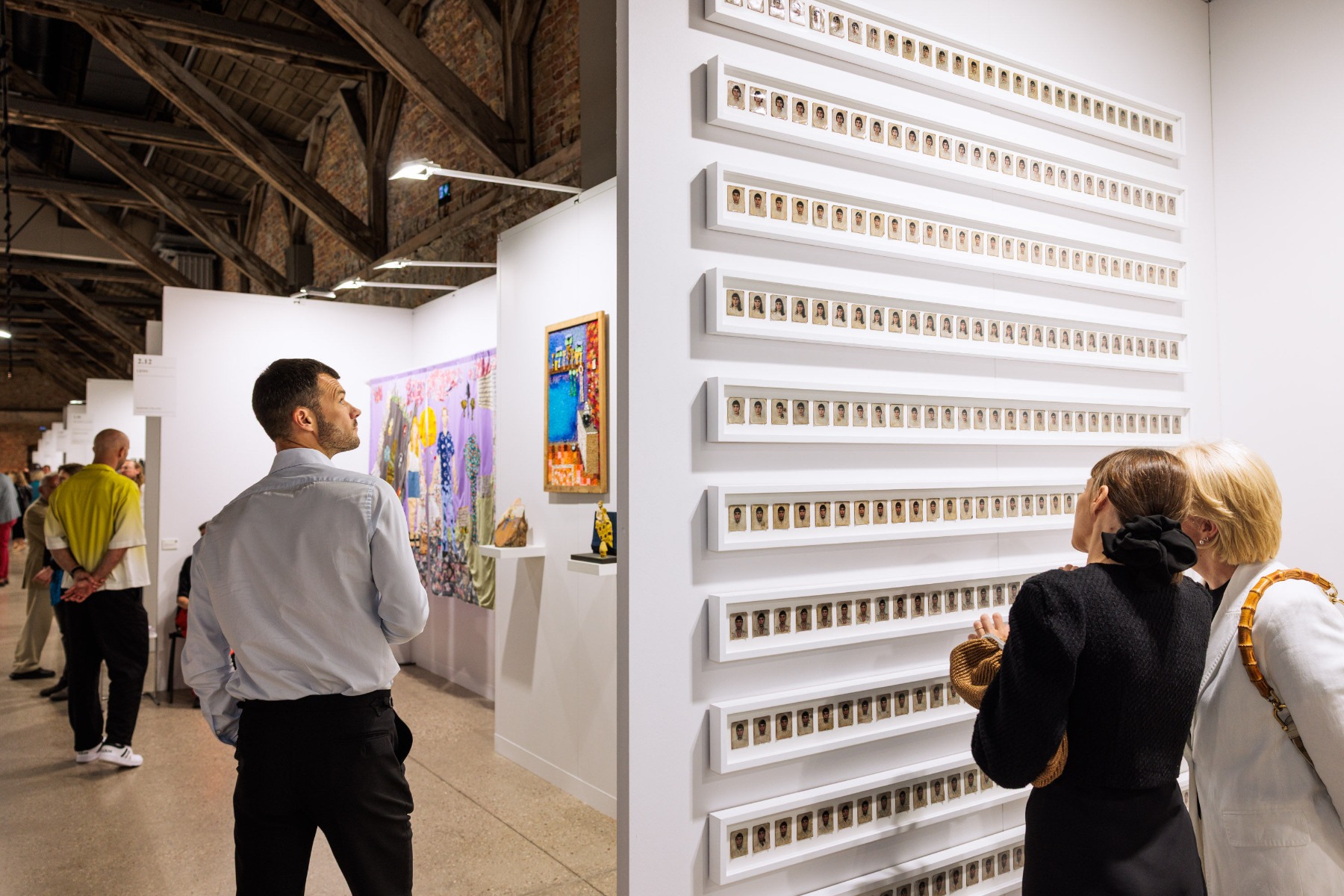
A great deal of credit for how Riga Contemporary turned out goes to the contemporary art center Kim?, the main organizer of the event. But the center also had its own "foreign minister," so to say – a consultant and advisor in shaping the very structure of the fair: Tokyo-based gallerist Jeffrey Rosen (his gallery is called Misako & Rosen, which he runs together with his wife, Misako Rosen). Jeffrey is also co-president of the New Art Dealers Alliance (NADA), an organization founded in 2002 that originally brought together American galleries interested in collaboration rather than constant competition and the race for success. Today, the organization operates internationally and brings together galleries from all over the world.
We spoke with Jeffrey about how he became so actively involved in Riga Contemporary, about the parallels between the situations faced by the art scenes in Japan and Latvia, and about how viable a model of collaboration truly is in the field of contemporary art.
At the opening of Riga Contemporary at Hanzas Perons. Photo: Ģirts Raģelis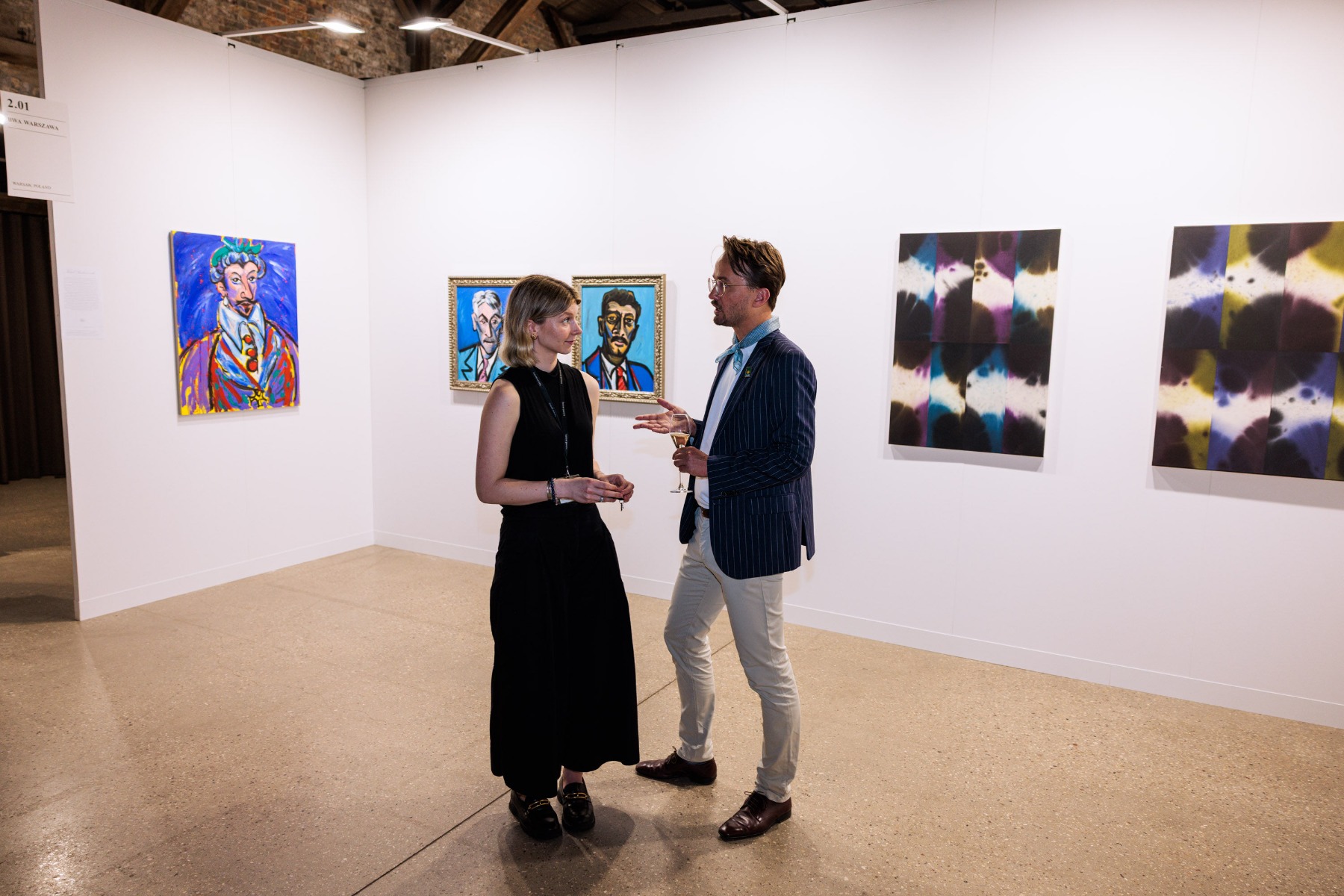
You are operating in Tokyo and I’m meeting you in Riga. Why? (Both laugh.)
Well, we’ve been collaborating on projects with Kim? for probably at least five years now, maybe even a bit longer. You might know that representatives from Kim? came to Japan for a project we organized – a hot spring retreat for galleries and artists running non-profit spaces, as well as a citywide exhibition.
Part of the reason is a bit anecdotal – and slightly embarrassing – and I’m not sure how relevant it is to the story, but it’s true. Many years ago, after dropping out of university, I spent some time in Latvia. I had only a vague memory of the city. The Baltics were a really interesting place for contemporary culture at the time, but I was very young, so it’s more of a blurry impression.
Later, I decided to do some research on what was happening in the region, and the space that seemed most internationally active – working with artists I was familiar with and found interesting – was Kim? here in Riga. So I reached out, and we began a correspondence and friendship that eventually led to collaborating on a few projects together.
I think Tokyo is a major cosmopolitan city, but the support for and interest in contemporary art is quite limited. The community is small and driven by a kind of labour of love among people who are truly passionate about contemporary art and culture. We're not working in a vacuum, but we also don't have much institutional support, nor a large audience, even though Tokyo is such a globally significant city.
Before we started working with Kim? and other partners in this region, we had already developed close ties with galleries in the United States and in other geographically peripheral locations – at least in terms of the power centers of the art world. For instance, one participant in this project, The Green Gallery from Milwaukee, is a very important space for international contemporary art despite being far from the traditional art world hubs. Another example is Good Weather, which is also participating here – they originally started their space in Little Rock, Arkansas, and have remained very active, operating from the periphery while engaging with the center.
So I see analogies between our collaborations with Kim? and the relationships we've built over the years with other off-center partners. We try to use the advantages of being located off center to create something distinct, with a different kind of energy.
Which actually leads to a lot of really interesting art. Because we’re not burdened by the pressures that come with being at the center of a commercial city, where culture is so heavily commodified – or in a city that is so central and prohibitively expensive, like New York, for instance. So, in many ways, what’s happening here reminds me a lot of what’s happening in Tokyo – just as Milwaukee did. To many people, that probably seems strange or unexpected. But it’s true.
At the opening of Riga Contemporary at Hanzas Perons. Photo: Ģirts Raģelis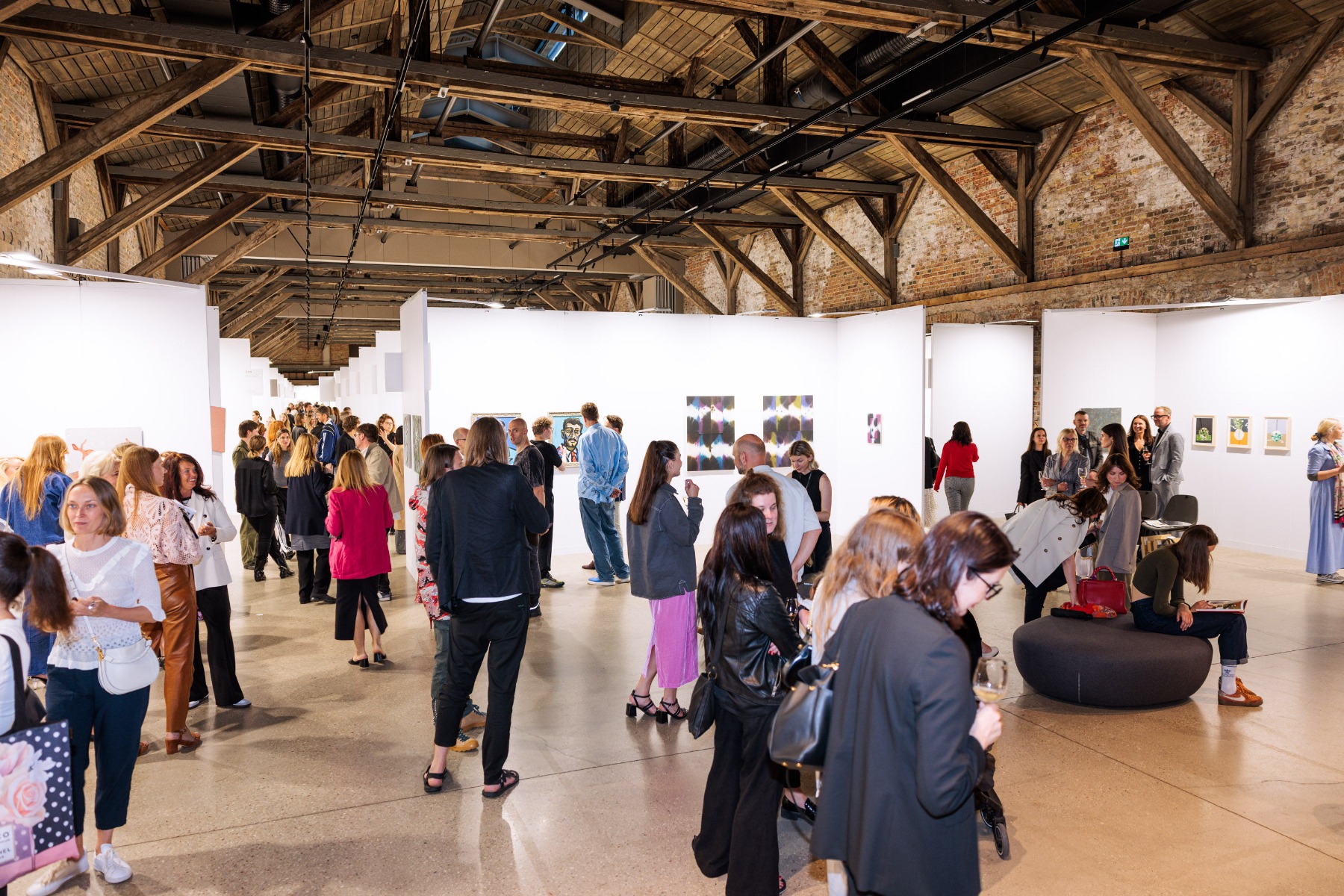
But what’s your sense of what’s happening here? How do you see it?
It's still really an uninformed perspective, but we came a couple of summers ago for a Sauna project organized by Kim?. And I would say that a space like 427 really reminds me of a space in Tokyo called XYZ Collective. What I mean is, it's an artist-run gallery – probably with a small but energetic audience – constantly producing projects. And when you're involved in them, they feel important, fun, and meaningful. But they’re not necessarily supported by an infrastructure that allows them to scale up quickly.
I think a space like Kim? fits a similar description. They regularly put on very interesting exhibitions that probably don't attract massive audiences, but the people who do engage are deeply devoted. In fact, the level of engagement often becomes a form of collaboration – artists supporting and working with each other just by showing up and participating.
So, a project like this art fair is actually quite interesting. I think the audience will likely be much larger than what these kinds of spaces are used to in terms of attention. It reminds me of something like Villa Warsaw, which has been happening in Poland for the past couple of years. Again, many of the participating galleries may not draw big audiences on their own, but when you gather an international group and call it an art fair, it registers differently – with a broader public, in a similar way to how a book fair does.
Anyway, my knowledge is still pretty limited – it's mostly based on intuition and a sense of analogy with similar situations and collaborators we know better, especially in places closer to us geographically, like the U.S.
At the opening of Riga Contemporary at Hanzas Perons. Photo: Ģirts Raģelis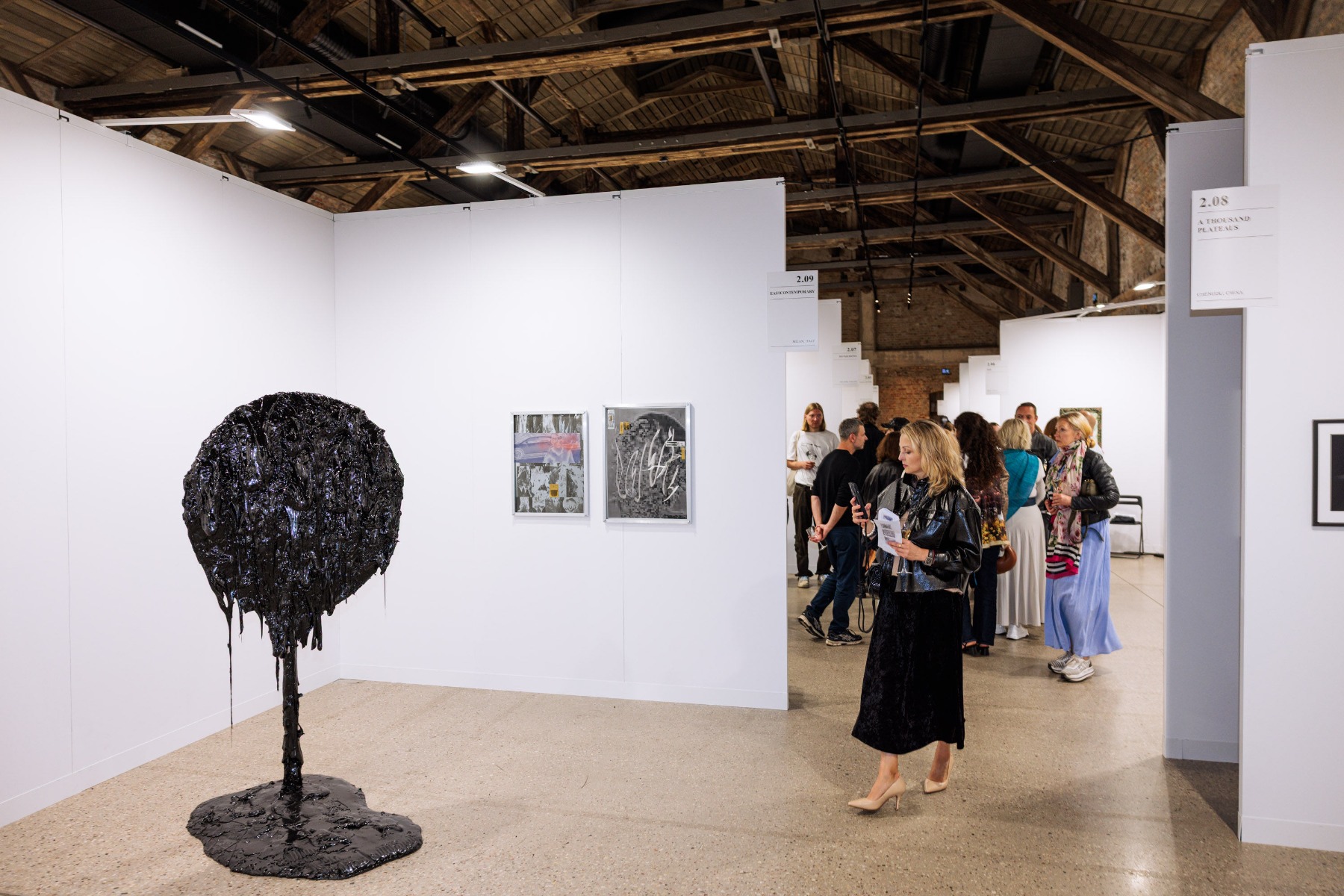
You were, as I understand, quite involved in shaping the course of this fair. What exactly was your role? What kind of input or advice did you contribute?
A lot of it was just nuts and bolts stuff. You know, an art fair follows a standard format – it’s not difficult to understand, you just have to know the schematic, right? Our gallery actually participates in an unusually large number of art fairs. Last year alone, we did 18 – that’s more than one a month. So, in terms of the structure of an art fair, I was able to contribute to that conversation. I wasn’t able to contribute much when it came to selecting participants from the region, though – my knowledge of the local scene is still pretty limited.
But outside of the region, our gallery has a pretty wide network, and I have a fairly good sense of who might be interested in this kind of project. It was a process of trial and error – helping to suggest people to invite, both from the perspective of whether Kim? would want to invite them and whether they’d be open to participating.
From the very beginning, we agreed it was important to keep the geography broad. We didn’t want it to be all galleries from Eastern Europe, or all from the U.S., for example. The idea was to cast a wide net, which is why there’s a gallery from Indonesia, one from Seoul, and three from Japan. That diversity was important not only for the overall flavor of the fair – to ensure a broad range of aesthetics, sensibilities, and personalities – but also to support the local scene. It sends a strong message: that people from all over the world are curious about what’s happening in Riga and are willing to travel a long way to engage with it.
At the opening of Riga Contemporary at Hanzas Perons. Photo: Ģirts Raģelis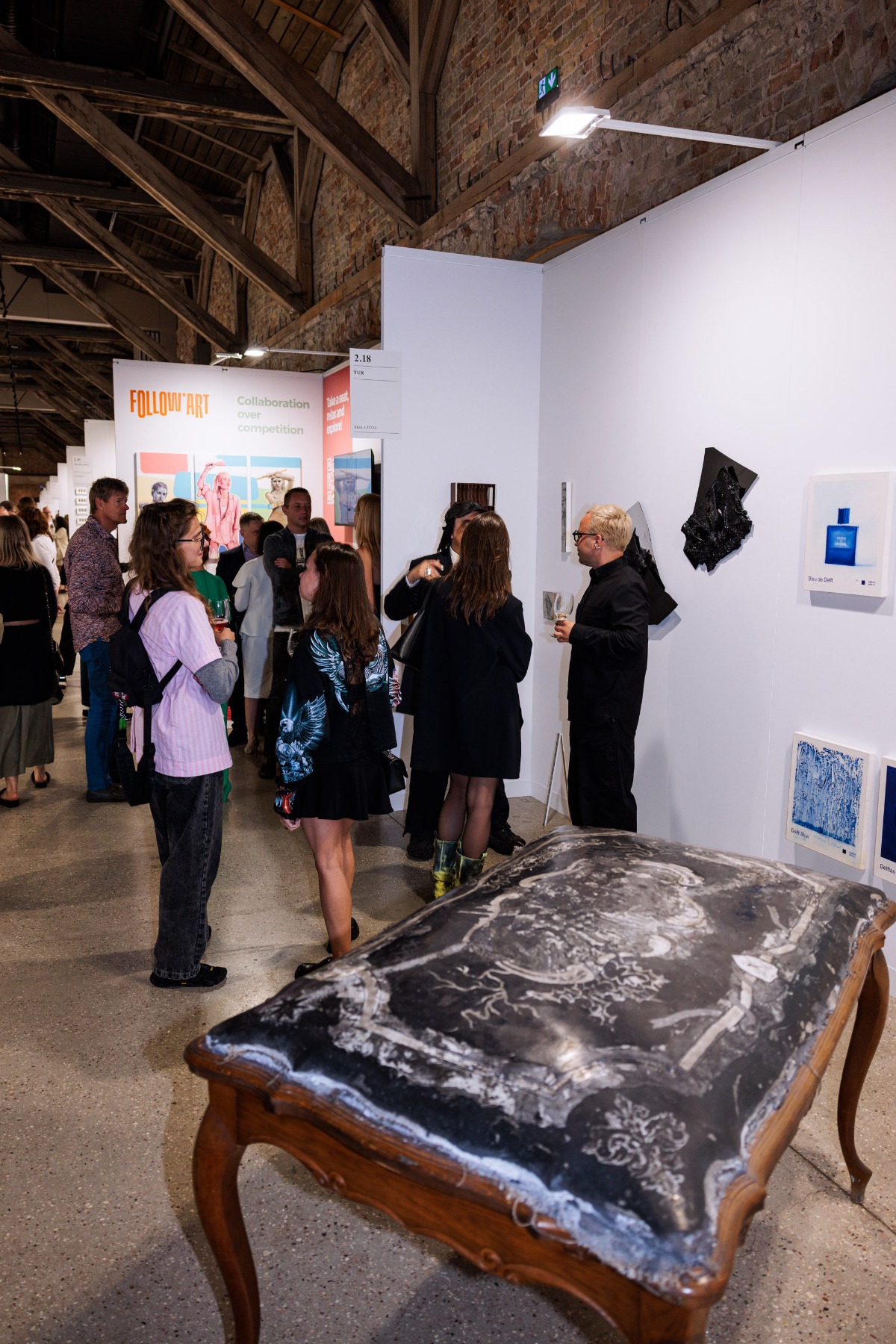
I understand that the idea of collaboration is quite central and meaningful for you – and perhaps for all the other galleries coming from abroad as well. It feels like a genuinely supportive gesture, especially considering they don’t know who will buy, or whether anyone will buy at all. Yet they still choose to take part.
Well, the other thing is, you know, to deemphasize – and this is a bit tricky. On the one hand, you want to downplay buying as the primary focus. But at the same time, when you talk about collaboration, you're talking about trying to develop a system of mutual support within the commercial art world – which, by its very nature, runs counter to a purely profit-driven approach to selling art. In that context, collaboration becomes a really useful tool. Mutual support becomes a really useful tool for surviving if you're not prioritising sales.
It's not to say that the galleries don't want to sell work when they're here, or that they don't at least hope, if not expect, to. But, you know, this is a relatively affordable fair to participate in. And that's also a gesture made towards the galleries – one that allows them to take that leap without taking on a tremendous risk. I mean, there's still a financial risk, and certainly a risk in terms of time. But the idea is to try and use this standard commercial format in a way that subverts it a little bit. Normally, at an art fair, it's the loudest booth with the strongest voice that wins. You have 60, 70, 160, 150 – whatever odd number of booths – and everybody's competing for people's attention.
The idea in this case is quite the opposite. It’s about how we create a more generally interesting environment through the things we do together – one that elevates everyone’s efforts rather than placing focus on a small group to the exclusion of others. For example, we’re collaborating with a gallery from the UK, but not from London – it’s actually based in Margate, so off-center. Kim is collaborating with Whistle from Seoul. This approach is about how we can support each other within a context that is usually seen as competitive.
One advantage of working in a space with relatively low stakes, in terms of cost, is that it allows you to experiment with helping each other rather than fighting for the small amount of money available. However, it’s often in these situations that people do end up competing fiercely, because there’s so little money, and everyone is fighting to get whatever they can for themselves. So we’re trying to subvert that and promote a different approach through our collaborations. There’s also another model you can follow within the commercial context.
At the opening of Riga Contemporary at Hanzas Perons. Photo: Ģirts Raģelis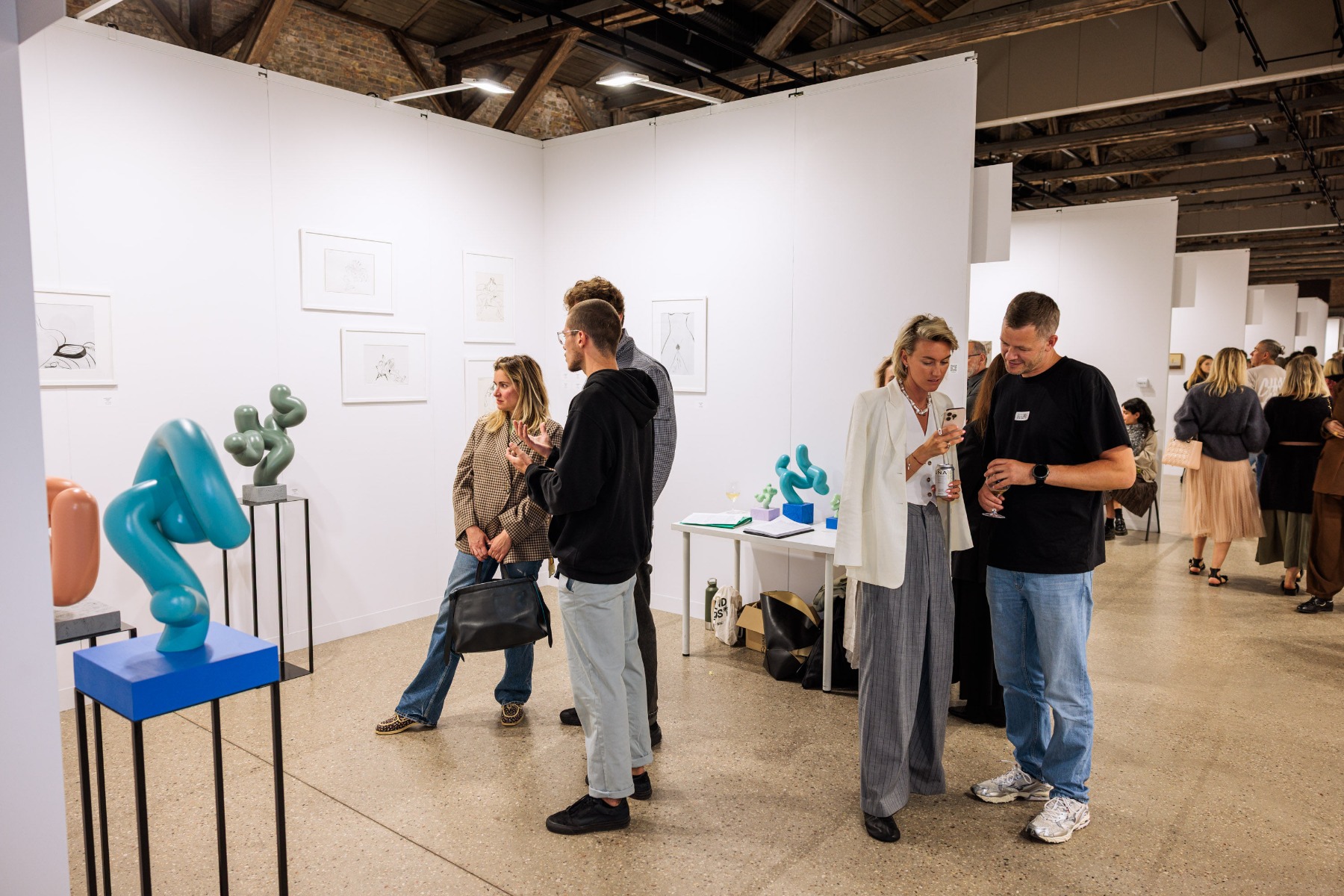
I’m personally quite happy that few galleries from Poland are coming to Riga Contemporary. Just yesterday, we had a conversation with Latvian artist Beate Poikāne. We talked about how Latvia and Lithuania are now often grouped with the Nordic countries, but actually, what we have here is quite different from the Scandinavian model economically and politically in many ways. However, with Poland, we share quite a lot in terms of history, politics, and culture. I think maybe now it’s possible to think about a kind of region that includes the Baltic countries, Poland, and perhaps a few others – but not all of Eastern Europe, as that’s too broad a concept.
Poland right now seems to be a real center of attention, especially with the reopening of the Contemporary Art Museum. These things tend to come in waves – there are trends and cycles. In the past, the Baltics weren’t so closely associated with what was happening in Poland, and were more aligned with Scandinavia. But maybe there’s a shift in how people are starting to perceive what ‘the region’ means. And who knows, maybe this project can be one small step in this direction. I was actually in Warsaw in April for the Villa Warsaw project, and there was a lot of good energy there.
Is it also like an art fair?
Yeah, it’s slightly more skewed toward being a festival, largely because of its history. In past years, when it returned to Poland – since Villa Warsaw originally began in Warsaw – it had already been realized in places like Reykjavik, Tokyo, and Toronto. In those locations, the project felt much more like a festival. But over the last couple of years back in Poland, I think due to the growing sense of a developing market, the project has shifted gears and become a bit more like a fair. That said, it still benefits from its origins, which were more freewheeling and experimental than a traditional trade fair.
And I think maybe it’s also a push to get Polish collectors more interested in non-Polish art. In the past, there was a lot of support for local artists, but not as much for international artists presenting work in the region.
At the opening of Riga Contemporary at Hanzas Perons. Photo: Ģirts Raģelis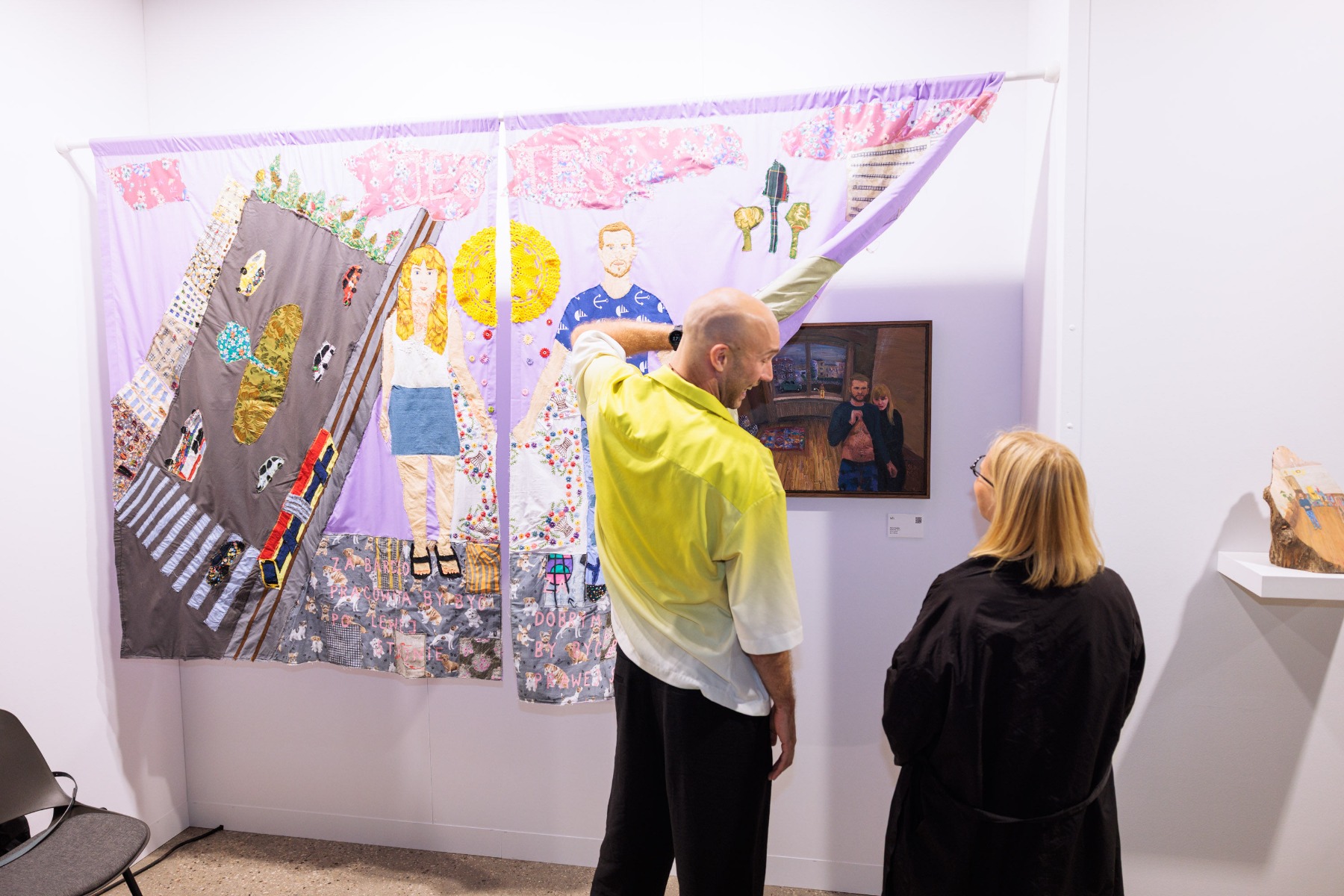
How would you describe the typical mid-level art collector in Japan – someone who isn't super wealthy but has some disposable income to spend on contemporary art?
Yeah, there aren’t that many. I mean, for a long time, that kind of mid-level collector was actually the foundation of art collecting in Japan. The typical example was the so-called salaryman collector – you know, the stereotype of the very hardworking Japanese office worker. Of course, it doesn’t really make sense anymore to use such a gendered term, but salaryman was the common phrase. That person wasn’t particularly wealthy, but they’d receive every twice a year a salary bonus large enough to maybe buy an artwork or two. That culture of collecting still exists to some extent. And now, there’s also a younger collector class – people working in the broader culture industry: video game designers, architects, fashion designers. Sometimes they buy contemporary art. But overall, it’s still a pretty small audience.
There’s no financial incentive to collecting art in Japan. So we don’t really have a speculative collector class – and in a way, that’s quite nice. But it also holds the market back from reaching the kind of scale you see in parts of Europe or the United States. For example, Japan has a fairly significant inheritance tax. So if someone builds a collection, they’re potentially creating a financial burden for the next generation – if there is a next generation. And considering Japan’s extremely low birth rate, maybe some collectors aren’t even thinking about inheritance, because there’s no one to leave it to. But generally, contemporary art is not part of the fabric of life in Japan.
Collecting contemporary art in Japan isn’t something that’s seen as a given for a particular social class. The audience is very small, and it's more or less what you’d expect – educated professionals, like doctors, lawyers, or hardworking office workers. There was a moment in the 1990s when things shifted a bit. You probably know that some Japanese artists, like Takashi Murakami and Yoshitomo Nara, were making work that drew heavily from manga and comics – something that ordinary people could easily relate to. For a while, that gave contemporary art a bit more visibility, maybe even helped attract people who wouldn’t otherwise engage with it. But that aesthetic isn’t the dominant one in Japanese contemporary art overall.
For many years, the market for contemporary Japanese art was primarily geared toward the domestic audience. As a result, the work was often more affordable and accessible to local collectors of modest means. But now that Japan has become more integrated into the global art market, prices have risen – and that shift has made it harder for those same collectors to keep up.
But are they mostly focused on local artists?
You know, the people who collect contemporary art in Japan are generally collecting internationally – they're not particularly focused on Japanese artists. We do have one major collection, the Takahashi Collection, which is explicitly devoted to contemporary Japanese art. But aside from that, most major collectors, even mid-level ones, tend to have an international focus. I think the success of artists like Murakami and Nara helped expose Japanese collectors to the global art world, and with that came the understanding that, by definition, contemporary art is international. It’s not something that’s strictly local – you need the broader conversation and context to build a meaningful contemporary collection.
Of course, you can choose to focus on your own region, but that has to be a very conscious choice. If it's not something that someone is focusing on, they just sort of assume that collecting contemporary means collecting from the region. In a way, they might not even be considered true contemporary collectors, because by doing so, they take the art out of its context – which, for better or worse, is international.
Are they mostly interested in paintings?
Well, we’re currently in a moment dominated by the “tyranny of the collector,” meaning that most people are primarily interested in paintings. But in Japan, this is also a practical issue. Even wealthy collectors face limitations regarding the size of the artworks they can accommodate, especially paintings. Some collectors also collect photography, but photography has long been a tough sell here. So, in that sense, collectors tend to be quite traditional.
Jeffrey Rosen together with gallerist Sophie Tappenier from Vienna at the booth he is sharing with Roland Ross Gallery, with works by Nathan Hylden in the background. Photo: Ģirts Raģelis
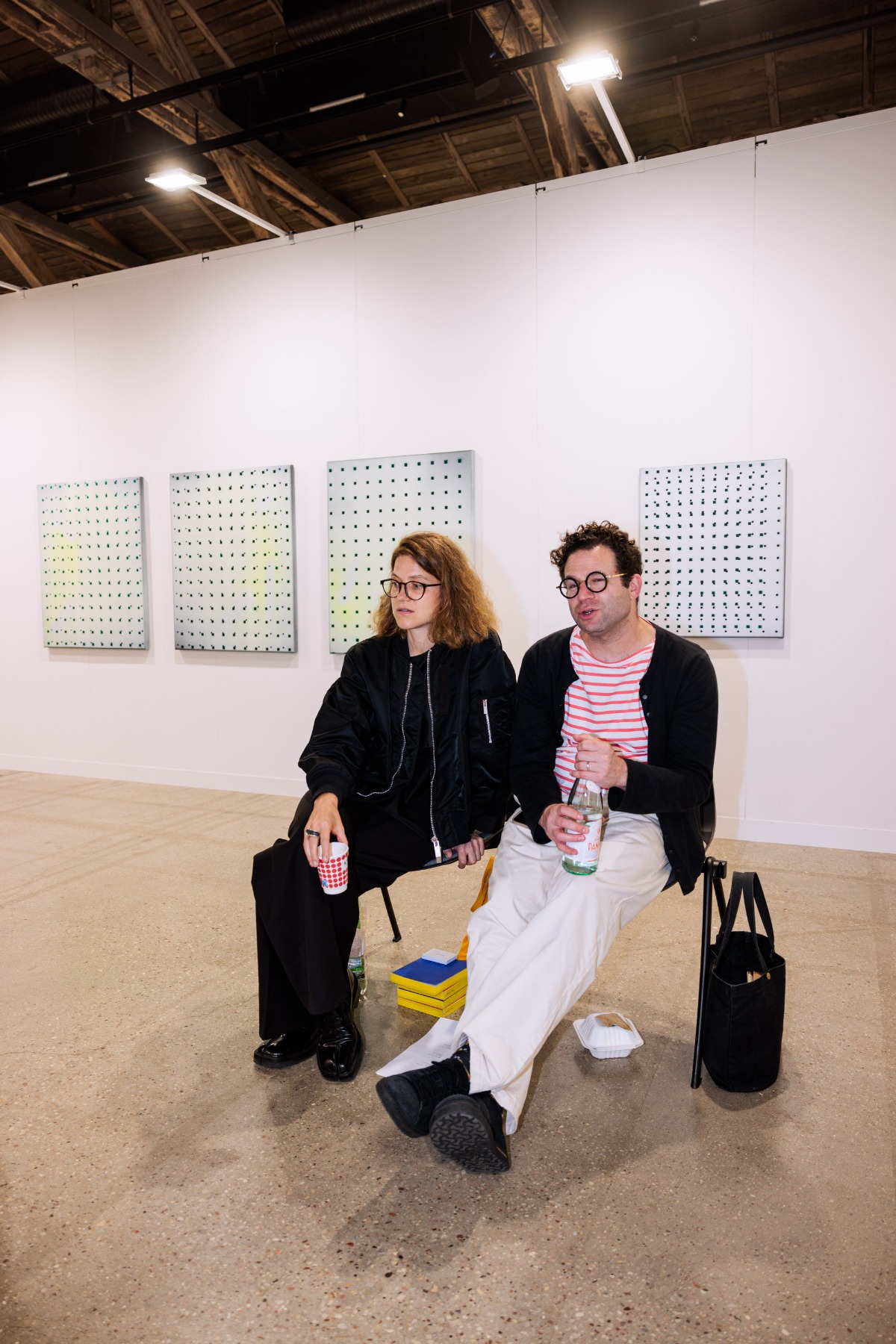
Which artists are you bringing here?
We’re collaborating with Roland Ross, a gallerist from Margate, who is showing the British artist Lawrence Lehman. We are presenting an American painter from Los Angeles named Nathan Hylden. There’s something about the work of these two artists in particular that made me really want to see them exhibited together. When we decided to participate in the first Riga Contemporary art fair, I saw it as an experimental context, and showing these two artists side by side felt like a natural experiment.
Both are relatively young artists who explore what it means to create minimal or minimal-looking art in a way that is challenging. Nathan is also one of the first five artists in our gallery program from the very beginning of our history. By presenting him here, we’re demonstrating our nearly 20-year-long support for his work. And his work definitely resonates with a Japanese audience. Although he’s not a Japanese artist, there’s something about his aesthetic that fits very naturally within Japan.
You’re also quite actively involved with NADA, the New Art Dealers Alliance, which is a relatively new name to us. How would you describe this organization and its history, considering it’s been around for more than 20 years now?
For me, the most important thing about NADA is its mission statement, which promotes non-adversarial art dealing. At its core, NADA believes galleries should work together rather than compete against each other. The model for this approach comes from the Dutch artist Daan van Golden – he wasn’t a gallerist, but he emphasized that art should be about collaboration, not competition.
Although NADA is headquartered in New York, where much of the contemporary commercial art world is centered, it has served for many years as an important resource, especially for American galleries. It fosters collaboration and cooperation among galleries, rather than rivalry. While it has always had an international reach, only fairly recently have there been board members from outside the United States. One of our gallery’s missions has been to help expand NADA’s reach globally, so galleries outside New York can benefit from the knowledge and experience of those based there. The goal is to help them learn how to navigate the contemporary art world’s center – but in a cooperative, not competitive, way.
A lot of what we do is about mentoring and sharing our experience from engaging with the center of the commercial art world. This helps galleries based outside the center understand how it functions, so they can participate effectively. NADA is a nonprofit organization with a staff (who are not gallery owners), but much of the work and many activities are self-directed by the galleries themselves.
And my last question: In one of your interviews, you were asked about the criteria for choosing artists to work with. You said, “We favor artists with a modest and literal-minded approach to their practice; also those with a sense of humor.” Is a sense of humor still a key criterion for you?
Yeah, it might not always come through in the way I talk, but definitely, a sense of humor is very important to us. A lot of what supports the financial structure of the art world is pretense, and one of the best ways to break through that pretentiousness is to make fun of it. We’re constantly engaged in a struggle, and one of the survival mechanisms is to be able to laugh at yourself and the situation, especially when things aren’t going well. We’re a bit anarchist in that way – we like to poke at power, and humor is one of the best ways to do that when power genuinely deserves to be challenged.
Our presentation here may seem very serious on the surface, but it’s actually quite humorous. I think it’s important not to take yourself too seriously, so yes, humor remains a key criterion for us. And many of the artists presenting at this fair are presenting stuff which is on some level funny.
The Riga Contemporary Art Fair is open until July 13, 2025. Admission is free with registration.
Title image: Jeffrey Rosen with Zane Čulkstēna, founder of Kim?, at the opening of Riga Contemporary